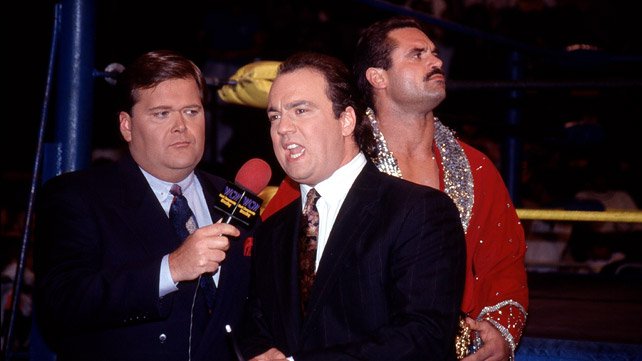mercredi 6 juin 2012

In this installment of looking at the various broadcast partners I’ve had the privilege of working with over the years, we remain in WCW during the late ’80s and the early ’90s.
Paul Heyman was a brash, talented New Yorker who was only 23 years of age when we became TV partners in Atlanta for WCW. The revolving door of the dysfunctional household known as World Championship Wrestling provided me the opportunity to work with several skilled individuals in various broadcasting roles, but none fit the antagonist role better than Scarsdale, N.Y.’s son of an attorney and a man I dubbed “Happy Heyman.”
Paul was a lifelong fan of the business, growing up on a steady diet of WWWF and beginning to attend events at Madison Square

WCW higher-ups never highly prioritized the show and gave me a free hand on who I wanted to work with on it. Many within WCW did not want to be around the bombastic Heyman, but I had a gut feeling that we just might click.
Paul grew up in the New York City market and knew it thoroughly. He used the “Page Six” column of the New York Post for some of his material, which served the program well. Now as for being on time for work, I occasionally had issues with the high strung, multi-tasking, up-all-night Heyman. But when Paul got in the announce booth, he was money. I’ve often said that Paul was “easy to dislike,” which is a supreme compliment for any villain of the genre.

Our on-air dynamic caused some fans to swear that we hated each other. Perhaps, some days, we did. Some of this angst was a result of the actual, organic tension Paul could elicit from me and, in reality, not all because of what his TV character said on the air. He was stubborn, as was I, and at times, I was not the most patient of mentors in the broadcast booth to my defiant “student.”
Heyman understood the wrestling business in a fashion that far belied his years. He immersed himself in the inner workings of the world of pro

But he could just be a pain in the buttocks at times.
The volatile Heyman was, more often than not, his own worst enemy in the corporate world of WCW, but he never failed to deliver the goods when we sat down to broadcast an event or weekly program. He knew how to provide a left-handed compliment to the fan favorites and how to properly embellish the villains, all the while being able to weave the wrestlers’ inner turmoils together, with the goal being to make the talent bigger stars.
Without question, Paul Heyman was one of the absolute best broadcast partners I ever teamed with and some fans feel he was the best with which I ever worked. He certainly knew how to bring out the best in me and what buttons needed to be pushed to produce combustible, spontaneous and memorable broadcasts involving the two of us.
Paul and I would reconnect in a

Like a handful of other partners, Paul Heyman made me better and often times lit a fire in me that others could not. I’d be happy to broadcast with him today in any capacity.

Missy Hyatt was another partner I worked with, generally in taped, studio settings while in WCW. She brought a much different dynamic to every broadcast.
Missy was another lifelong fan who, through working in various wrestling territories as a valet and manager, had much more of a working knowledge of the business than she’s ever likely been given credit for having.
Missy obviously brought an element of sex appeal and a bodacious personality to the broadcasts and played her role extremely well. Like many great performers in sports-entertainment and entertainment in general, sometimes art imitated life. Some days, that was a good thing, and some days, it wasn’t.
She was light-years ahead of today’s TMZ-oriented society as she brought unique, topical subjects to many of our broadcasts, all done spontaneously and without someone feeding her lines.
Missy Hyatt understood her role better than many of those who followed her in sports-entertainment broadcasting, no matter the gender, simply because she understood the business, felt the product and was being, essentially, her natural self on TV.
The Tallahassee, Fla., native was truly a pioneer when it comes to beautiful women in pro


To a significant degree, the Divas of the sports-entertainment world can thank Missy Hyatt for paving the way for them to have the opportunity to earn a great living and to be afforded other opportunities as a result of appearing on

When Missy and I did our on-camera bits to throw to matches, fans need to remember that we had no script, no teleprompter and no writers assisting us. What we did, good or bad, was a result of our own, natural chemistry and Missy being Missy.
Missy Hyatt had no true female role models in pro

Working with controversial and talented people like Paul Heyman and Missy Hyatt did not come without its challenges. However, both of these strong personalities had important things in common; they both grew up as fans; by hook or crook, each worked their way into the business via the wrestling territories in non-in-ring capacities, and both came out on the other side to become significant and memorable TV characters when the genre was gaining a national foothold via cable TV.
Next … two of the best broadcasters and most controversial figures ever in the business … Jim Cornette and Jesse Ventura.
Click here to order J.R.'s famous BBQ sauce on WWE Shop and follow the WWE Hall of Famer on Twitter.
Inscription à :
Publier les commentaires
(Atom)
0 commentaires:
Enregistrer un commentaire